Switching play
This session is about maximising space so as to be able to switch the ball quickly in creating positive attacking options. And at the heart of this is helping players recognise when to play forward and when to switch play. It’s important to practise this because moving the ball quickly with both short and long passes gives us the chance to create 1v1 situations or overloads, which are key situations for exploiting the opposition.

| Area | Up to a half pitch |
| Equipment | Balls, cones |
| No. of Players | Up to 8v8 plus keepers |
| Session Time |
Passing drills 10mins each, Games 20mins each |
This session is about maximising space so as to be able to switch the ball quickly in creating positive attacking options. And at the heart of this is helping players recognise when to play forward and when to switch play.
It’s important to practise this because moving the ball quickly with both short and long passes gives us the chance to create 1v1 situations or overloads, which are key situations for exploiting the opposition.
Keeping possession under pressure and knowing when to switch is a major part of our style of play. For that reason, we’ll work on this type of session frequently.
What do I get the players to do?
Passing drill 1
Set up as shown, with two players on each corner, and two balls starting at opposite corners (1). In each square, the two players in possession pass and follow to their right until they make it back to their starting places. We’ll then restart the practice with players moving in the opposite direction.
1
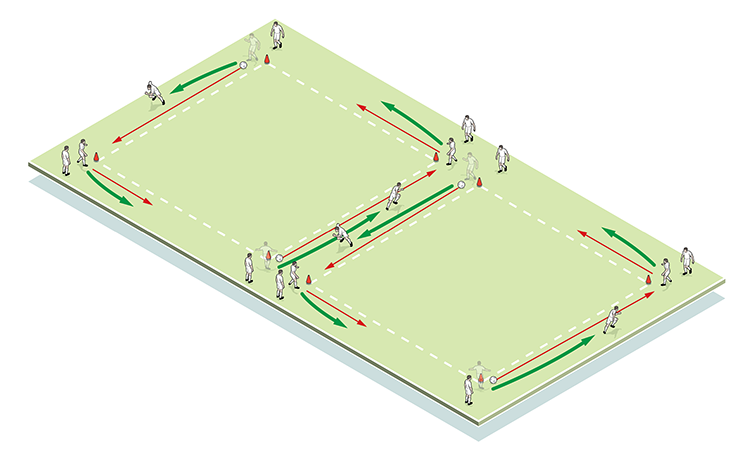
We like to set up with two squares going in competition with each other – which team can complete the task quickest?
Passing drill 2
We now add in two players midway along two opposite sides. These players either receive on the back foot and move forward (2a), or set the ball for the approaching player (2b), depending on the coach’s instruction. Again, players follow their passes until they return to their starting places.
2a
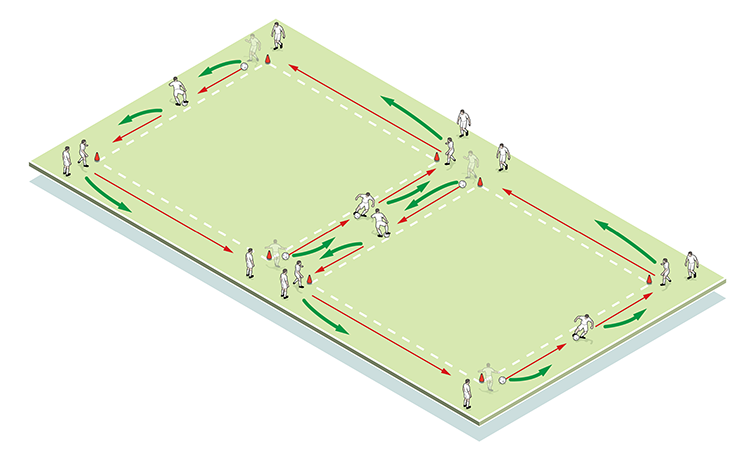
2b
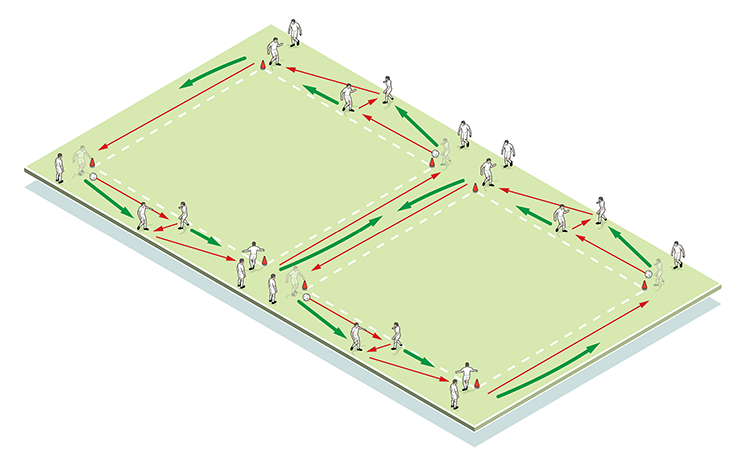
What are the key things to look out for?
The emphasis here is on passing quickly, receiving on the back foot and playing at a high tempo. Players must communicate and concentrate at all times.
Directional possession game, 8v8
This game is full width, played in the area between the penalty box and the halfway line. Setting up as shown, teams can dribble through any of the end line goals being attacked (3a) or in the middle goal (3b). If scoring in the middle goal, the ball must be passed to a team mate on the other side for the goal to count, and it cannot then come straight back through.
3a
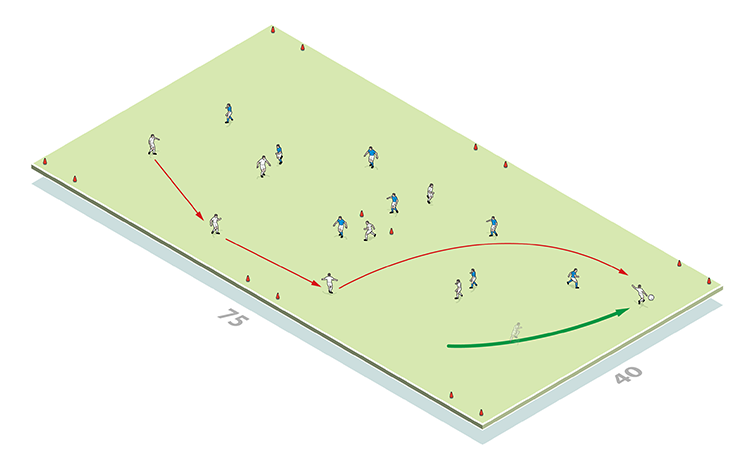
3b
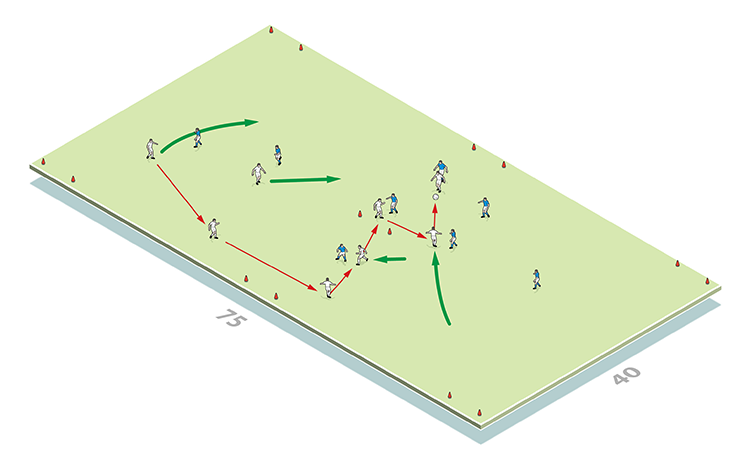
8v8 game with keepers
Now on a half pitch, we’re looking for players to use the full width and to switch the ball, in the process creating overload situations and breaks (4). We might choose to introduce three-touch to ensure the ball is moved quickly.
4
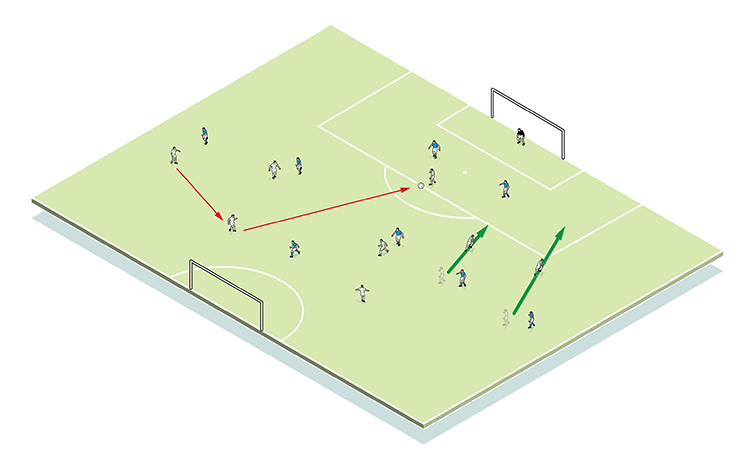
What are the key things to look out for?
Players should show excellent awareness, move the ball quickly out of tight areas and make forward runs at pace.
Technical skills are important – particularly receiving on the back foot – but players must also resist challenges and be comfortable passing the ball over a variety of different distances.
Editor's Picks
Attacking transitions
Deep runs in the final third
Using the goalkeeper in build-up play
Intensive boxes drill with goals
Penetrating the final third
Creating and finishing
My philosophy
Pressing initiation
Compact team movement
Coaches' Testimonials

Alan Pardew

Arsène Wenger

Brendan Rodgers

Carlos Carvalhal

José Mourinho

Jürgen Klopp

Pep Guardiola

Roy Hodgson

Sir Alex Ferguson

Steven Gerrard
Coaches' Testimonials

Gerald Kearney, Downtown Las Vegas Soccer Club

Paul Butler, Florida, USA

Rick Shields, Springboro, USA

Tony Green, Pierrefonds Titans, Quebec, Canada
Join the world's leading coaches and managers and discover for yourself one of the best kept secrets in coaching. No other training tool on the planet is written or read by the calibre of names you’ll find in Elite Soccer.
In a recent survey 92% of subscribers said Elite Soccer makes them more confident, 89% said it makes them a more effective coach and 91% said it makes them more inspired.
Get Monthly Inspiration
All the latest techniques and approaches
Since 2010 Elite Soccer has given subscribers exclusive insight into the training ground practices of the world’s best coaches. Published in partnership with the League Managers Association we have unparalleled access to the leading lights in the English leagues, as well as a host of international managers.
Elite Soccer exclusively features sessions written by the coaches themselves. There are no observed sessions and no sessions “in the style of”, just first-hand advice delivered direct to you from the coach.









